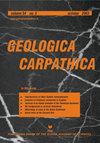奥地利Radstadt上古新世-始新世型地的双叶藻Furcoporella diplopora Pia(1918):新注释和分类意义
IF 1.5
4区 地球科学
Q4 GEOSCIENCES, MULTIDISCIPLINARY
引用次数: 0
摘要
摘要/ Abstract摘要:双叶藻(1918)显示出一种特殊的结构,由一对分化的、相当模糊的孔组成。由于这种结构,Furcoporella属一直存在争议。目前,对其在大纲纲中的分类地位仍未达成一致意见。本文根据奥地利Radstadt/Pongau地区上古新世至始新世碳酸盐地层中Pia的模式材料,对模式种F. diplopora Pia(1918)进行了重新描述。对这种材料进行了新的观察,使人们能够获得关于这种完全被忽视的藻类的更多和更完整的资料。讨论了该菌体的一些形态特征,特别是侧枝的形态特征,并对其潜在的分类意义进行了评价。最后,根据解释,Furcoporella属属于triploporellacae科,更具体地说,它应该被置于Thyrsoporelleae部落。本文章由计算机程序翻译,如有差异,请以英文原文为准。
Dasycladalean alga Furcoporella diplopora Pia (1918) from the type-locality (upper Paleocene–Eocene, Radstadt, Austria): new remarks and taxonomic implications
Abstract The dasycladalean green alga Furcoporella diplopora Pia (1918) exhibits a peculiar structure comprising pairs of diverging and rather indistinct pores. Because of such structure, the genus Furcoporella has been a matter of debate. Currently, there is still no agreement on its taxonomic position within Dasycladales. This paper provides a re-description of the type-species F. diplopora Pia (1918), based on Pia’s type material from the upper Paleocene to Eocene reworked carbonates of Radstadt/Pongau, Austria. New observations carried out on this material allowed the acquisition of additional and more complete data on this quite neglected alga. Some morphological characteristics of the thallus, specifically of the laterals are discussed and a suite of potential taxonomic implications are evaluated. Finally, according to interpretations the genus Furcoporella is ascribed to the Family Triploporellaceae and more specifically it should be placed within the tribe Thyrsoporelleae.
求助全文
通过发布文献求助,成功后即可免费获取论文全文。
去求助
来源期刊

Geologica Carpathica
地学-地球科学综合
CiteScore
2.40
自引率
23.10%
发文量
26
审稿时长
>12 weeks
期刊介绍:
GEOLOGICA CARPATHICA covers a wide spectrum of geological disciplines including geodynamics, tectonics and structural geology, volcanology, stratigraphy, geochronology and isotopic geology, karstology, geochemistry, mineralogy, petrology, lithology and sedimentology, paleogeography, paleoecology, paleobiology and paleontology, paleomagnetism, magnetostratigraphy and other branches of applied geophysics, economic and environmental geology, experimental and theoretical geoscientific studies. Geologica Carpathica , with its 60 year old tradition, presents high-quality research papers devoted to all aspects not only of the Alpine-Carpathian-Balkanian geoscience but also with adjacent regions originated from the Mediterranean Tethys and its continental foreland. Geologica Carpathica is an Official Journal of the Carpathian-Balkan Geological Association.
 求助内容:
求助内容: 应助结果提醒方式:
应助结果提醒方式:


